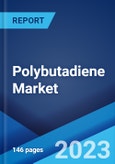The global polybutadiene market size reached US$ 5.2 Billion in 2022. Looking forward, the publisher expects the market to reach US$ 6.7 Billion by 2028, exhibiting a growth rate (CAGR) of 4.1% during 2023-2028.
Polybutadiene is a synthetic elastomer formed via free radical polymerization of multiple 1,3-butadiene monomers to make a long polymer chain molecule. It has excellent elasticity, resistance to abrasion, and low hysteresis loss, heat buildup, and coefficient of friction and strength properties. As a result, it is used to manufacture high-quality tires around the world. It is also utilized as an additive to improve the toughness or impact resistance of plastics, such as polystyrene, high-impact polystyrene (HIPS), and acrylonitrile butadiene styrene (ABS).
Polybutadiene is a synthetic elastomer formed via free radical polymerization of multiple 1,3-butadiene monomers to make a long polymer chain molecule. It has excellent elasticity, resistance to abrasion, and low hysteresis loss, heat buildup, and coefficient of friction and strength properties. As a result, it is used to manufacture high-quality tires around the world. It is also utilized as an additive to improve the toughness or impact resistance of plastics, such as polystyrene, high-impact polystyrene (HIPS), and acrylonitrile butadiene styrene (ABS).
Polybutadiene Market Trends:
The boosting sales of vehicles across the globe is positively influencing the need for high-performance tires. This represents one of the key factors stimulating the market growth. Moreover, due to the resistance of polybutadiene to low temperatures, it is increasingly being employed in the automobile industry to manufacture belts, gaskets, inner tubes of hoses for sandblasting, and pneumatic and water hoses cover. Apart from this, the flourishing construction industry is driving the demand for polystyrene plastics as an insulated panel system for walls, roofs, and concrete floors in residential and commercial buildings. These plastics are also being utilized in civil engineering projects, road and railway development, and manufacturing pontoons and marinas, which is acting as another major growth-inducing factor. Apart from this, polybutadiene is gaining traction as a substitute for natural rubber (NR) in the production of golf balls cores and various elastic objects and for coating or encapsulating electronic assemblies, which further aids in offering high electrical resistivity. This, along with the increasing focus of major players operating around the world on mergers and acquisitions (M&A) activities, is anticipated to propel the growth of the market.Key Market Segmentation:
The publisher provides an analysis of the key trends in each sub-segment of the global polybutadiene market report, along with forecasts at the global, regional and country level from 2023-2028. The report has categorized the market based on product, type and industry vertical.Breakup by Product:
- High Cis Polybutadiene
- Low Cis Polybutadiene
- High Trans Polybutadiene
- High Vinyl Polybutadiene
Breakup by Type:
- Solid Polybutadiene Rubber
- Liquid Polybutadiene Rubber
Breakup by Industry Vertical:
- Tire
- Automotive
- Chemical
- Industrial Rubber Manufacturing
- Others
Breakup by Region:
- North America
- United States
- Canada
- Asia-Pacific
- China
- Japan
- India
- South Korea
- Australia
- Indonesia
- Others
- Europe
- Germany
- France
- United Kingdom
- Italy
- Spain
- Russia
- Others
- Latin America
- Brazil
- Mexico
- Others
- Middle East and Africa
Competitive Landscape:
The competitive landscape of the industry has also been examined along with the profiles of the key players being Evonik Industries AG (RAG-Stiftung), JSR Corporation, Kumho Petrochemical Co. Ltd., Kuraray Co. Ltd., Lanxess AG, Nippon Soda Co. Ltd., Reliance Industries Limited, Saudi Basic Industries Corporation (Aramco Chemicals Company), Synthomer PLC, Synthos (Ftf Galleon S.A.), UBE Corporation and Versalis (Eni S.p.A.).Key Questions Answered in This Report:
- How has the global polybutadiene market performed so far and how will it perform in the coming years?
- What has been the impact of COVID-19 on the global polybutadiene market?
- What are the key regional markets?
- What is the breakup of the market based on the product?
- What is the breakup of the market based on the type?
- What is the breakup of the market based on the industry vertical?
- What are the various stages in the value chain of the industry?
- What are the key driving factors and challenges in the industry?
- What is the structure of the global polybutadiene market and who are the key players?
- What is the degree of competition in the industry?
Table of Contents
1 Preface3 Executive Summary11 Value Chain Analysis13 Price Analysis
2 Scope and Methodology
4 Introduction
5 Global Polybutadiene Market
6 Market Breakup by Product
7 Market Breakup by Type
8 Market Breakup by Industry Vertical
9 Market Breakup by Region
10 SWOT Analysis
12 Porters Five Forces Analysis
14 Competitive Landscape
Companies Mentioned
- Evonik Industries AG (RAG-Stiftung)
- JSR Corporation
- Kumho Petrochemical Co. Ltd.
- Kuraray Co. Ltd.
- Lanxess AG
- Nippon Soda Co. Ltd.
- Reliance Industries Limited
- Saudi Basic Industries Corporation (Aramco Chemicals Company)
- Synthomer PLC
- Synthos (Ftf Galleon S.A.)
- UBE Corporation
- Versalis (Eni S.p.A.).
Methodology

LOADING...
Table Information
| Report Attribute | Details |
|---|---|
| No. of Pages | 146 |
| Published | September 2023 |
| Forecast Period | 2022 - 2028 |
| Estimated Market Value ( USD | $ 5.2 Billion |
| Forecasted Market Value ( USD | $ 6.7 Billion |
| Compound Annual Growth Rate | 4.3% |
| Regions Covered | Global |
| No. of Companies Mentioned | 12 |









